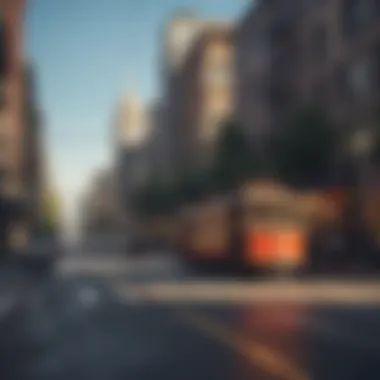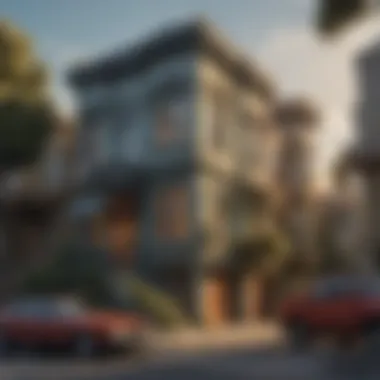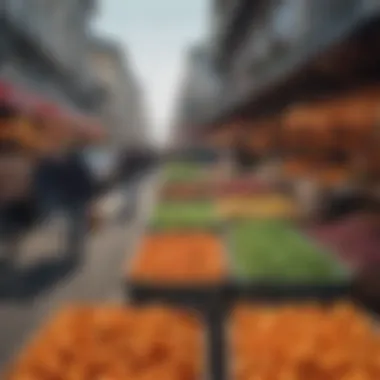Top Car-Free Neighborhoods to Stay in San Francisco


Intro
We will highlight various neighborhoods that provide easy access to public transport, local attractions, and a lively atmosphere, allowing visitors to immerse themselves in the culture and lifestyle of the city. Each neighborhood possesses its own charm and distinct offerings, ensuring a fulfilling experience for every traveler.
Inspiring Homes
While discussing neighborhoods, the types of accommodations available play an essential role. Visitors accessing the city without a vehicle can find numerous places to stay, ranging from upscale properties to cozy lodgings.
Luxury Properties
In the heart of San Francisco, areas like Nob Hill and Pacific Heights boast luxury accommodations. These neighborhoods are home to extravagant hotels such as The Fairmont and The Ritz-Carlton. Staying in these locations provides not only comfort and elegance but also proximity to cultural landmarks such as Grace Cathedral and numerous upscale dining options.
Cozy Retreats
For those seeking a more intimate experience, neighborhoods like Noe Valley and Castro offer charming guesthouses and boutique hotels. Places like the Noe's Nest Bed and Breakfast provide a cozy atmosphere and personalized service. Visitors can enjoy local cafes and parks while being conveniently located near public transportation.
Unique Architectural Styles
San Francisco is renowned for its distinctive architecture, from Victorian houses to modern high-rises. When seeking accommodation, it is worth considering places like the historic Hotel Nikko, which combines classic Japanese design with contemporary amenities. Staying in such unique properties enhances the overall experience of exploring the city's architectural richness.
Stunning Locations
Accessibility to stunning views and vibrant settings is crucial for any traveler. The following neighborhoods not only feature beautiful landscapes but also allow guests to easily access attractions.
Cityscapes
The Financial District and South Beach are ideal for those who want a modern urban landscape. Here, visitors can experience the dynamic atmosphere filled with bustling eateries, shops, and waterfront parks. The proximity to public transport also makes it easy to explore other neighborhoods.
Exotic Destinations
While San Francisco may not typically feature remote paradises, areas like Golden Gate Park feel like an escape from urban life. Visitors can stay nearby in places like Richmond or Sunset and enjoy nature walks, beautiful gardens, and museums.
Travel Guides
Exploring a city requires information on what to see and do. Each neighborhood has its own attractions worth exploring.
Destination Guides
The Mission District stands out with its iconic murals and a rich culinary scene. Lodging choices here, such as boutique hotels and hostels, provide affordable access to vibrant street life and delicious eateries.
Travel Tips
Using Muni and BART is the best way to get around. It's advisable to check public transport schedules and routes ahead of time to maximize the experience and minimize wait times.
“San Francisco's public transport network connects you to almost every corner of the city. Knowing the best stops and lines can greatly improve your travel experience.”
Closure
San Francisco offers a wealth of neighborhoods suitable for car-free living. Each area has its unique flavor, attractions, and accessibility. From luxury accommodations in historic settings to cozy retreats in friendly neighborhoods, travelers can find suitable places to stay. The key is to choose wisely, ensuring that the experience embodies the spirit of this iconic city.
Prelude to San Francisco
San Francisco is a city that captivates with its blend of history, culture, and natural beauty. It is often regarded as a unique destination not just for its iconic landmarks like the Golden Gate Bridge, but also for its vibrant neighborhoods. For those planning a visit without a car, understanding the layout and characteristics of this urban landscape becomes essential.
The importance of knowing where to stay in San Francisco for a car-free experience cannot be overstated. The city boasts an efficient public transportation system, including buses, trams, and ferries, which provide easy access to various attractions. This makes it feasible for visitors to explore without the need for a personal vehicle. Furthermore, San Francisco's diverse neighborhoods each offer their own charm, culture, and accessibility, allowing travelers to pick their environment based on personal preferences.
Travelers can enjoy the freedom to wander through streets filled with rich history and eclectic architecture. Walkability is a significant aspect, with many areas encouraging pedestrians to explore at their own pace. San Francisco also presents numerous opportunities for cultural engagement, from street fairs to art galleries.
Overall, this section sets the stage for a comprehensive analysis of neighborhoods and the choices available for those who wish to maintain a car-free lifestyle while immersed in San Francisco's urban experience. Being informed about these considerations can enhance enjoyment during your stay.


The Necessity of Car-Free Travel
Traveling without a car in urban areas like San Francisco offers several key advantages. Many visitors find that opting not to drive enhances their experience by allowing for a more immersive engagement with their surroundings. Traffic congestion, expensive parking, and high fuel costs can add stress and logistical challenges to a trip. In contrast, embracing a car-free lifestyle contributes to a more relaxed atmosphere, where time can be spent enjoying the diverse sights, sounds, and flavors of the city.
Environmental Considerations
Choosing to travel car-free can have a significant impact on the environment. Urban areas like San Francisco struggle with air pollution and greenhouse gas emissions from vehicles. By avoiding cars, individuals can help reduce their carbon footprint.
- Reduced Emissions: Public transportation options, such as buses and trains, produce fewer emissions per passenger compared to individual cars. This collective approach lessens the overall environmental burden.
- Conservation of Resources: Less reliance on cars also conserves natural resources. This includes reduced fossil fuel consumption, which is especially important in the context of climate change.
- Encouraging Sustainable Practices: Many neighborhoods emphasize sustainability. Markets featuring local foods and businesses that prioritize eco-friendly practices become more accessible when one walks or uses public transit.
This collective act of travel not only benefits the environment but also encourages communities to adopt greener practices.
Urban Design and Walkability
San Francisco's urban design promotes walkability, making it suitable for visitors who want to explore without a vehicle. The city's infrastructure offers a range of features to support pedestrians and public transport users.
- Dense Population Centers: Areas with high population density reduce the necessity for cars, making local attractions, restaurants, and shops easily reachable on foot.
- Pedestrian-Friendly Streets: Many neighborhoods, such as Fisherman's Wharf and Chinatown, involve streets designed for safe pedestrian navigation, featuring wide sidewalks and adequate signage.
- Accessible Public Transport: The Muni and BART systems integrate well with urban planning, allowing for easy access to different parts of the city without the use of a car.
In sum, urban design in San Francisco fosters an environment where car-free travel is not just possible, but arguably preferable.
Key Factors When Choosing a Location
When planning a visit to San Francisco without a car, selecting the right location becomes vital for an enjoyable experience. Factors such as public transport accessibility, proximity to major attractions, and overall safety contribute significantly to the convenience and enjoyment of a car-free visit. Each of these elements not only impacts daily logistics but also influences the overall ambiance and richness of the travel experience.
Public Transport Accessibility
Accessibility to public transport cannot be overstated. San Francisco boasts a robust public transit system that includes buses, trams, and the BART train. This extensive network allows visitors to navigate the city efficiently without a car. Areas like Union Square and Fisherman's Wharf have ample public transport options. This means that you don’t need to worry about lengthy walks or expensive taxi rides to get around. When choosing accommodations, consider the distance to nearby transit stations, as this can reduce travel time and enhance the convenience of daily outings.
Proximity to Attractions
Being close to popular attractions is crucial for maximizing your time in San Francisco. Many neighborhoods are rich in unique experiences, from the cultural streets of Chinatown to the historic landmarks in Nob Hill. Staying near attractions minimizes the need for transport and allows for spontaneous detours to restaurants or shops. Key areas provide direct access to sights like the Golden Gate Park, the San Francisco Museum of Modern Art, and various waterfront attractions. Prioritize neighborhoods that offer both a vibrant local scene and easy access to must-see sites. This approach ensures that you enjoy a more immersive experience, taking advantage of everything the city has to offer.
Safety and Comfort
Safety is an equally important consideration when selecting your stay. The urban landscape of San Francisco varies significantly, with some areas considered safer and more welcoming than others. Choosing a neighborhood known for its security can alleviate concerns, enabling visitors to explore freely. Look into local reviews or safety statistics to make an informed decision. In addition to safety, comfort plays a key role. Look for places that not only have the right amenities but also provide a welcoming environment that makes you feel at home. A comfortable stay enhances the likelihood of enjoying your time in the city, especially after a long day of exploration.
"Accessibility, proximity to attractions, and safety are three pillars that support an enjoyable car-free experience in San Francisco."
In sum, understanding and weighing these key factors is essential when choosing a location in San Francisco for a car-free experience. Ensuring accessibility, convenience, and safety will contribute significantly to your journey.
Top Neighborhoods for Car-Free Stays
Finding the right neighborhoods in San Francisco for car-free stays is crucial for visitors who want to make the most of the city without the hassle of driving. Different areas of this vibrant city offer unique features that cater to various interests and needs. Whether one seeks shopping, culture, or exceptional dining experiences, there are certain neighborhoods that rise above the rest. The benefits of exploring on foot or utilizing public transit cannot be overstated. It allows for a more immersive experience, uncovering hidden gems and everyday life in the city while avoiding the stress of parking and traffic.
Union Square
Shopping and Dining Options
Union Square is the heart of shopping in San Francisco. This area is filled with a diverse array of stores, from high-end boutiques to large department stores. Dining options range dramatically from casual eateries to extravagant fine dining restaurants. The vibrancy here adds to the appeal; visitors can easily seek out meals that cater to various tastes and preferences. A significant consideration is that it serves as a social hub. Many events and performances happen at Union Square, making it a lively spot to both shop and dine.
Access to Public Transport
Union Square is strategically located with excellent access to public transportation. The Market Street corridor, which runs nearby, provides performance connections to BART and Muni service. This accessibility means that visitors can easily explore other parts of the city, making it a prime choice for car-free stays. If you want to go to the Mission District, for example, or hit the waterfront at Fisherman’s Wharf, public transport does not disappoint.
Fisherman's Wharf
Waterfront Activities
Fisherman's Wharf offers stunning waterfront activities that draw large crowds. From sea lion watching at Pier 39 to sunset cruises on the bay, the options are plentiful. Visitors experience the essence of San Francisco while enjoying the beauty of the Pacific Ocean. This area's charm lies in its casual vibe. Walking along the waterfront and taking in the scenery is a pleasure in itself, making it a beneficial location for those who prefer not using a car.
Tourist Attractions


Fisherman's Wharf is home to several iconic tourist attractions such as Ghirardelli Square, the Maritime National Historical Park, and the famous cable cars. These attractions are within walking distance of each other, promoting a leisurely exploration. Such features enhance the appeal for car-free visitors, as the ability to wander freely and encounter new spots without needing to drive adds significant value to the overall experience.
Chinatown
Cultural Experiences
Chinatown offers rich cultural experiences that are unparalleled in the city. The vibrant streets are filled with shops selling traditional goods, and visitors can experience a deep-rooted culture that reflects the neighborhood's history. This immersion into cultural traditions adds a unique essence to a car-free visit. Wander through shops offering unique items, from herbal medicines to traditional clothing.
Walking Tours
Walking tours in Chinatown are a fantastic way to engage with the neighborhood’s history and culture. Guided or self-directed, these tours reveal the hidden stories behind the shops and streets, promoting a deeper understanding of this vibrant community. The layout of Chinatown encourages exploration, allowing tourists to easily navigate without needing a vehicle, enhancing both accessibility and experience.
The Mission District
Art and Culture
The Mission District is a hub for art and culture, featuring colorful murals and vibrant galleries. This neighborhood showcases both contemporary and traditional art forms, making it a cultural milestone in San Francisco. Visitors are drawn to this area for its artistic vibe, where creativity thrives. The presence of art not only beautifies the area but also creates an inviting atmosphere for those exploring without a car.
Diverse Cuisine Options
With its rich cultural blend, the Mission District offers diverse cuisine options, making it a culinary paradise. From authentic Mexican food to trendy cafes, every palette can find satisfaction. This variety also means that visitors can enjoy meals from different cultures, enhancing their travel experience. Easy accessibility to restaurants encourages those exploring on foot to venture out for different dining options without the reliance on a vehicle.
Nob Hill
Luxury Accommodations
Nob Hill features an array of luxury accommodations that cater to discerning travelers. High-end hotels offer breathtaking views and impeccable service, making it a desirable location for those seeking comfort. Being centrally located makes Nob Hill a prime location for exploring other parts of the city. The convenience of staying there enhances the overall experience, especially for guests who wish to enjoy the finer things without the burden of driving.
Historical Landmarks
This neighborhood is rich in historical landmarks, such as Grace Cathedral and the Cable Car Museum. Exploring these sites on foot allows visitors to appreciate the architectural beauty and historical significance. Learning about the city’s past while strolling through its streets adds depth to a car-free experience. It encourages visitors to engage more deeply with the city's history and landscape.
North Beach
European Influence
North Beach exudes a strong European influence that enhances its charm. Known for its Italian heritage, the area is dotted with cafes and restaurants that reflect this culture. The relaxed atmosphere encourages visitors to slow down, sip a coffee, and soak in the surroundings. This feeling of being in a European neighborhood makes it a unique experience for travelers who prefer walking over driving.
Nightlife Scene
The nightlife scene in North Beach is lively and diverse. From jazz clubs to cocktail lounges, there are options for anyone looking to unwind in the evening. The vibrant atmosphere attracts those who cherish nighttime adventures. Easy walking access means that visitors can enjoy the nightlife to the fullest without worrying about transportation at night.
SoMa (South of Market)
Tech Scene
SoMa is at the forefront of San Francisco's tech scene, housing several well-known tech companies and startups. The modern vibe attracts a young, innovative crowd, making it an appealing destination for visitors. Exploring this area on foot allows for insight into the city’s contemporary character, showcasing how technology shapes urban life. Visitors can easily interact with this tech-focused environment without the need of a car.
Art Galleries
Visitors can discover numerous art galleries in SoMa, showcasing both local and international artists. These galleries offer a blend of contemporary and established art forms. The accessibility of these cultural institutions makes SoMa ideal for the art enthusiast traveling without a vehicle. Walking from gallery to gallery provides an enriching experience into the local art scene, blending culture with convenience.
Haight-Ashbury
Counterculture History
Haight-Ashbury is celebrated for its rich counterculture history, especially during the 1960s. The area still reflects this cultural legacy with its colorful murals and hippie shops. For visitors wanting to delve into this aspect of San Francisco's past, a car-free exploration is ideal. Those visiting can experience the enchantment of this historical context without rushing from one place to another.
Unique Shops
The unique shops in Haight-Ashbury offer a myriad of eclectic items, from vintage clothing to handmade crafts. This variety makes shopping here a delightful adventure. Walking the streets allows visitors to take their time and discover one-of-a-kind items that they would not find elsewhere. The absence of cars promotes a leisurely shopping experience filled with exploration.


Transportation Options in San Francisco
San Francisco is a city that thrives on accessibility and convenience, particularly for those choosing to navigate without a car. Understanding the different transportation options available can greatly enhance your experience. The city features a mix of public transit, ridesharing services, and paths for biking and walking. Being aware of these choices is essential to get the most out of your visit. Each option has unique benefits and can make your stay not only easier but also more enjoyable.
BART and Muni Systems
BART (Bay Area Rapid Transit) and Muni are the backbone of public transportation in the San Francisco Bay area.
- BART connects San Francisco with nearby cities like Oakland and Berkeley, making it a great choice for travelers who wish to explore beyond the city limits. It offers a reliable service with multiple lines and frequent trains, allowing easy access to various neighborhoods and attractions.
- Muni serves the city directly. It includes buses, streetcars, and the iconic cable cars. Not only does Muni provide extensive coverage of San Francisco, but its integration within the city's landscape makes it extremely efficient for covering short distances as well. The ability to purchase a day pass allows unlimited rides, which can be a cost-effective choice for tourists.
Each system caters to different needs and preferences, giving visitors flexibility in managing their travel plans. Both BART and Muni also have apps to provide real-time updates, helping to optimize your travel time. Overall, utilizing BART and Muni can save time and reduce stress for those who do not use a car.
Ridesharing Services
Ridesharing has become a popular mode of transport in San Francisco. Services like Uber and Lyft offer convenient, on-demand rides with just a few taps on your smartphone.
- Flexibility is one of the primary advantages of ridesharing. Whether you need to get to a restaurant, event, or a different neighborhood, there's usually a driver available nearby.
- Cost is another factor to consider. While fares might be higher during peak hours, ridesharing can still be more economical than taxi services, especially if you are traveling in a group.
- Additionally, the integration of ridesharing services with public transport provides a seamless experience when needing to connect from one part of the city to another. However, note that traffic congestion can impact travel times, particularly in busy areas.
Biking and Walking Paths
Biking and walking are excellent alternatives to traditional transportation in San Francisco. The city's moderate climate and scenic views make it ideal for outdoor travel.
- Biking: San Francisco offers several bike rental services, both individual bike rentals and bike-sharing programs like Bay Wheels. Dedicated bike lanes make it easier and safer to navigate the streets, especially in areas like the Embarcadero and along the waterfront. Biking provides a sense of freedom and a unique perspective of the city's landmarks.
- Walking paths are plentiful. Many neighborhoods are compact, and walking allows visitors to immerse themselves in the local culture. Places such as Golden Gate Park and the Presidio have extensive trails that encourage exploration.
Both biking and walking also encourage a healthier lifestyle while limiting the city's environmental impact.
Navigating the city without a car does not limit your experience; rather, it opens up new possibilities in urban exploration.
Practical Tips for Traveling Without a Car
Traveling without a car in a city as vibrant as San Francisco has its own unique set of challenges and opportunities. This section aims to equip travelers with practical advice that enhances their experience while navigating the city without the comfort of personal transportation.
Planning Your Itinerary
Creating a strategic itinerary is crucial for a seamless travel experience. Without a car, it's important to cluster your activities based on proximity. This can minimize travel time and maximize enjoyment. Start by identifying key neighborhoods you wish to explore. A good practice is to utilize San Francisco's extensive public transportation system to connect these areas efficiently.
Moreover, consider the timing of your visits to major attractions. Places like Alcatraz or the Exploratorium often require advance reservations. Planning your time around these considerations can prevent unnecessary delays. Use transit apps and maps to determine routes. Being organized can save you valuable time.
Packing Light
Packing light is essential for urban exploration. Heavy bags can become burdensome, especially when using public transport or walking long distances. Aim for a small, manageable backpack that contains only the essentials. This includes:
- Lightweight clothing suitable for San Francisco's variable weather
- A refillable water bottle to stay hydrated
- A portable charger for your devices
- Comfortable footwear for walking
Remember, you can often find laundry services or laundromats around the city if you need to refresh your clothes. This approach not only saves space but also makes mobility easier.
Staying Safe in Urban Environments
Safety is an important consideration, particularly when unfamiliar with an area. San Francisco is generally safe, yet it is wise to remain aware of your surroundings. Here are some tips to ensure safety:
- Stick to well-lit and populated areas, especially at night.
- Keep your valuables secured and avoid displaying them openly.
- Use trusted apps like Uber or Lyft for extra convenience if you feel uncomfortable.
Maintaining situational awareness and using common sense are key components to navigating urban environments securely.
Public transport can be an excellent way to avoid risky situations. Familiarize yourself with transit routes and timetables. If possible, travel in numbers. This can enhance your experience while also adding a layer of security.
Ending
In evaluating the significance of the ideal locations to stay in San Francisco without a car, several aspects come to the fore. This article highlights how embracing a car-free travel experience not only aligns with sustainable practices but also enriches the urban exploration notably.
One crucial element is the accessibility of public transport in these neighborhoods. Areas like Union Square and Fisherman’s Wharf stand out because they provide easy connections to various parts of the city, making it feasible to traverse San Francisco with convenience and efficiency. Moreover, the availability of ridesharing services and biking paths reinforces the idea that navigating the city is very much possible without a personal vehicle.
Additionally, consider the proximity to attractions. Each recommended neighborhood has a plethora of cultural and recreational offerings. Tourists can find numerous shopping, dining, and entertainment options within walking distance. This encourages a deeper engagement with San Francisco’s vibrant atmosphere, allowing visitors to immerse in local culture instead of being confined to a vehicle.
Safety and comfort also play a substantial role. Each neighborhood discussed offers varying degrees of safety, which can greatly impact the overall travel experience. Selecting a location that prioritizes personal safety can reduce stress and promote relaxation during one's stay.
This article presents a clear picture of how visitors can efficiently navigate San Francisco without a car, emphasizing the benefits of exploring the city on foot or through reliable public transport systems. By recognizing the harmony between urban mobility and local experiences, tourists can enhance their journey while minimizing their environmental footprint.



